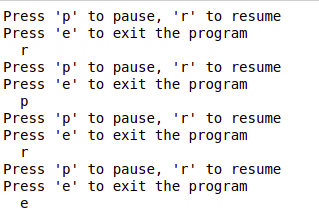

- #PYTHON PLAY SOUNDS DRIVER#
- #PYTHON PLAY SOUNDS PORTABLE#
- #PYTHON PLAY SOUNDS CODE#
- #PYTHON PLAY SOUNDS FREE#
Supports stereo and mono but not compression and decompression Reads and writes audio files in AIFF or AIFC format (Audio Interchange File Format)Īn interface to the WAV sound format. Manipulates raw audio data.Operates on sound fragments consisting of signed integer samples 8, 16, or 32 bits wide, stored in Python strings These are included under Multimedia Services and listed in Table 4.27. Python, of course, comes with a few sound functions built-in.
#PYTHON PLAY SOUNDS CODE#
The kit can be found on its own Sourceforge page, along with on-line documentation, code examples, utilities, applications, and musical scores at.
#PYTHON PLAY SOUNDS PORTABLE#
The DSP tools are only portable to Intel systems or m68k, but the MIDI and sound streaming are available on Windows and Mac platforms (at the time of this writing the project team was still working on a port to Linux). These are C tools made available to Python using PyObjC or the Objective-C bridge. The kit is based on Music V (From Bell Labs and Max Mathews) and was originally written for NeXT. MusicKit is a full, object-oriented library for signal processing and building sound, music, and creating MIDI applications. Snack is accessed using the tkSnack module. It adds the snack:sound command, which is used to create and handle sound objects, read audio data from wav files, and play sounds. Snack needs both Tkinter and Tcl/Tk to work correctly. It supports MP3 and sound filtering the idea behind the kit is rapid development. It is a sound-processing toolkit with a TK interface. The Snack Toolkit was developed by Kare Sjolander for TCL and Python.

īoodler combines sound samples into an ongoing stream of sound for background noise. An interesting tool for creating soundscapes which uses Python and is created for UNIX operating systems (although some work on PDAs, Mac, and with Direct X has been done).

#PYTHON PLAY SOUNDS FREE#
PythonWare is a copyrighted, but free to use, library.īoodler. The unfinished tookit is still available from PythonWare at. An (unfortunately) abandoned kit for reading and playing AU, VOC, and WAV files on Windows and Sun OSs. Like with graphics, there are a number of available libraries for implementing sound in Python. This flag is not supported on modern Windows platforms.Sound in Python Sound in Python Sound in Python
#PYTHON PLAY SOUNDS DRIVER#
Specifies that the function must return if the sound driver is busy. Specifies that sounds currently playing must not be interrupted. Specifies that if the specified sound is not found, the system default sound must not be played. Specifies that the function should return immediately, allowing for the sound to play in the background. This flag is not supported on modern Windows platforms. Specifies that all instances of the given sound must be stopped. Using this flag together with winsound.SND_ASYNC will raise a RuntimeError. Specifies that the sound is a byte-like object that contains data in WAV format. This is a blocking call in order to play the sound in a loop in the background, must be specified. Specifies that the sound must be played repeatedly. If the built-in sound does not exists, the default system sound is played, unless winsound.SND_NODEFAULT is specified. Specifies that the sound parameter given is a built-in sound. Specifies that the sound parameter given is a WAV file name. The following table summarizes the different flags and their usage:

These flags provide additional commands to the play sound function. flags is a parameter that takes in winsound.SND_ flags.Note: If a built-in sound is passed, then flags must include the winsound.SND_ALIAS flag. The following table summarizes the built-in sounds in every Windows platform: sound is an object that specifies the sound This can be a file name, a built-in sound name, or a sound-like object in memory that is to be played.The syntax of the PlaySound function is as follows: winsound.PlaySound(sound, flags) The PlaySound function plays or stops a given WAV sound file. The winsound module in Python 3 provides an interface to interact with the sound playing machinery in Windows.


 0 kommentar(er)
0 kommentar(er)
